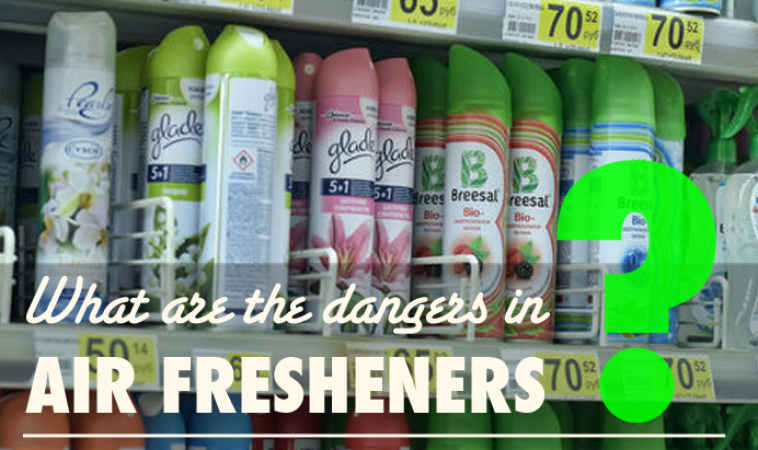“Pssst. . .” The sound of your neighbor eager to share a choice piece of gossip at the water cooler? No, it’s the automatic “air freshener” at your work place squirting out a measured spray of synthetic fragrance designed to give the air a pleasing fragrance, covering up something considered less pleasing. The nose is the one sense organ that is directly connected to the brain.¹ What is inhaled quickly and directly affects the brain and mind. So, for our health’s sake, “What’s in that spray can of “air freshener” being automatically dispensed into our breathing space(s), how might that affect our health, and given the air quality need(s) of public indoor spaces, what, if any, alternatives are there?
In my search for ingredients of the product used, for example, at our local branch library I found a Material Safety Data Sheet According to it, a long list of characteristics and considerations have been reviewed including Hazards Identification, Composition / Information of Ingredients, First Aid Measures, Fire-fighting Measures, Accidental Release Measures, Handling and Storage, Exposure Controls / Personal Protection, Physical and Chemical Properties, Stability and Reactivity, Toxicological Information, Ecological Information, Disposal Information and Transport Information.²
Nevertheless, the Data Sheet is hardly revealing:
- “Potential environmental hazards – This product has not been tested;
- “Hazardous decomposition products – May include and are not limited to: Oxides of Carbon;
- “Chronic effects – The finished product is not expected to have chronic health effects;
- “Carcinogenicity – The finished product is not expected to have chronic health effects (* see below);
- “Ecotoxicity – This product has not been tested;
- “Environmental effects – Not available;
- “Other adverse effects – Not available.”²
Only two ingredients were actually identified: Ethanol and Sodium tetraborate decahydrate (borax).²
We might be familiar with ethanol, or “gasohol”, as a government mandated gasoline additive / substitute said to be effective in lowering greenhouse gases and reducing the need for petroleum imports while also boosting gasoline octane, improving engine power.³ Ethanol, it turns outs, is also widely used in the fragrance industry as a solvent. In fact, a carbon based petrochemical, ethanol is considered “an aggressive solvent” due to its hungry molecular status.³,⁴ It absorbs water from the air, is capable of corroding steel fuel tanks and is “hostile to fiberglass.” Vehicles with a steel or fiberglass gas tank and fiberglass boats risk severe damage with the use of ethanol.³ In addition, the American Conference of Government Industrial Hygenists (ACGIH) rates ethanol, as an A3 carcinogen — “a confirmed animal carcinogen with unknown relevance to humans.”⁵ This rating was indicated on the Material Safety Data Sheet in small print under Carcinogenicity, after the claim of no chronic health effects expected*.
Borax might also be familiar from a popular laundry soap booster. It’s commercial uses are many including agricultural fertilizers, flame retardant, wood preservative, pesticide, fungicide and metallurgical applications. It is also used by the pharmaceutical and cosmetic industries as a pH buffer, a mild antiseptic and an emulsifier.⁶
Searching further for ingredient information, the example products own website provided the following in their FAQS section:
- “Birds are sensitive to fragrances and have delicate respiratory systems. Therefore caution should be used when using products such as this around birds;
- “DO NOT breathe spray;
- “DO NOT spray towards face;
- “May be harmful if directly inhaled;
- “May cause allergic reaction in some individuals;
- “DO NOT get in eyes;
- “Contains propellants, petroleum solvent and fragrance.”⁷
Searching further on the Environmental Protection Agency’s website four basic ingredients in air fresheners” are listed: “formaldehyde, petroleum distillates, p-dichlorobenzene (moth balls), and aerosol propellants.”⁸
On the EPA blogsite “Our Planet, Our Home” an article by Lina Younes entitled “Are Air Fresheners Helpful or Harmful?” notes air quality issues in home and work place are compounded by poor ventilation, and that while the products are “only masking other odors. . .these air fresheners have volatile organic compounds (VOCs) like formaldehyde and petroleum distillates which can be very irritating to eyes, skin and throat. . .and that even unscented [varieties] can produce allergic reaction.”⁹
Finally, on a website discussing the differences between synthetic fragrances and those from essential oils, the question is asked “What Aren’t They Telling Us?” and the given answer is “the FDA does not require fragrance manufacturers to disclose the ingredients of synthetic fragrances” as they are proprietarily protected under the FDA’s “trade secret” law.10
In brief, synthetic “air fresheners” are volatile petrochemical hydrocarbon compounds with toxic effects on the brain directly accessible through our sense of smell, which some of us willingly buy and use while seeking to improve our air quality. We wouldn’t likely willingly spray formaldehyde into our living rooms or moth balls into our bedrooms, but we do so unwittingly at home and work place via discreet packages cleverly marketed through our noses as desirable and hospitable.
In Part 2, we’ll explore more thoroughly how air quality and fragrance, synthetic and natural, affects our health, and beyond that, what better “air freshening” choices we might make.
 Katy Nelson, ND, (Bastyr ’94), with an office since 1997 in Michigan’s rural Upper Peninsula on the shores of beautiful Lake Superior, promotes our Nature devoted profession through consultation, writing and mentoring. She is joined by Bastyr grad, former mentoree and Pediatric specialist, Alicia Smith Dambeck, LAc CH (also ad locum in St. Paul with Amy Johnson Grass, ND). Since 2011, Dr. Katy has been ad locum herself in SW FL for family matters.
Katy Nelson, ND, (Bastyr ’94), with an office since 1997 in Michigan’s rural Upper Peninsula on the shores of beautiful Lake Superior, promotes our Nature devoted profession through consultation, writing and mentoring. She is joined by Bastyr grad, former mentoree and Pediatric specialist, Alicia Smith Dambeck, LAc CH (also ad locum in St. Paul with Amy Johnson Grass, ND). Since 2011, Dr. Katy has been ad locum herself in SW FL for family matters.
References:
- Aromatherapy, The Therapeutic Use of Essential Oils. Aromatherapy, The Therapeutic Use of Essential Oils. Available at: http://www.anandaapothecary.com/aromatherapy.html. Accessed May 17, 2015.
- Material Safety Data Sheet. 2010. Available at: http://www.rbnainfo.com/msds/ca/canada%20-%20air%20wick%20aerosol%20-%20english.pdf . Accessed May 15, 2015.
- Sherman, D. Living with Ethanol. Ethanol Gas. 2013. Available at: https://www.hagerty.com/articles-videos/articles/2013/08/19/living-with-ethanol. Accessed May 17, 2015.
- Schiller, M. Ethanol as a Solvent . Ethanol as a Solvent – EasyChem – The Ultimate Resource for HSC Chemistry: Syllabus-Based Dot-Point Study Notes/Summaries, Past Exam Papers, and More. 2010. Available at: http://www.easychem.com.au/production-of-materials/renewable-ethanol/ethanol-as-a-solvent. Accessed May 17, 2015.
- ACGIH classification. ACGIH classification. Available at: http://www.crios.be/general_classification/acgih.htm. Accessed May 17, 2015.
- BORAX DECAHYDRATE (Sodium Tetraborate Decahydrate). BORAX DECAHYDRATE (Sodium Tetraborate Decahydrate). Available at: http://www.chemicalland21.com/industrialchem/inorganic/borax%20decahydrate.htm. Accessed May 17, 2015.
- Air Wick® Frequently Asked Questions. Air Wick® FAQs. Available at: http://www.airwick.us/faqs. Accessed May 17, 2015.
- Learn About Chemicals Around Your House. EPA. 2014. Available at: http://www.epa.gov/kidshometour/products/airf.htm. Accessed May 17, 2015.
- Younes, L. Are Air Fresheners Helpful or Harmful? The EPA Blog. 2012. Available at: http://blog.epa.gov/blog/2012/02/are-air-fresheners-helpful-or-harmful/. Accessed May 17, 2015.
- Essential Oils vs. Synthetic Fragrance. Way Out Wax. Available at: http://www.wayoutwax.com/store/pc/viewcontent.asp?idpage=9. Accessed May 15, 2015.

















